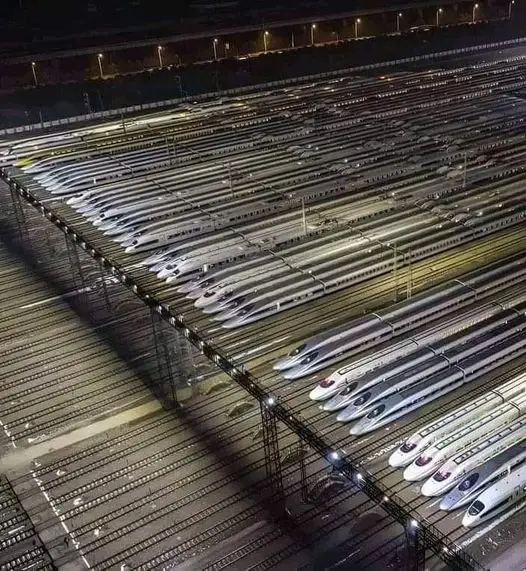The Impressive Fleet of High-Speed Trains in China: A Transportation Revolution
China has long been known for its innovation and rapid development, and nowhere is this more evident than in its high-speed rail network. With thousands of sleek, modern trains operating daily, China has created the world’s most extensive and advanced high-speed rail system. Let’s delve into the marvels of this transformative infrastructure and how it has reshaped transportation, economic growth, and mobility.

The Rise of High-Speed Rail in China
From Vision to Reality
China’s journey into high-speed rail began in the early 2000s when the government recognized the need for a faster, more efficient mode of transport to connect its sprawling cities. Today, it boasts a rail network that stretches over 42,000 kilometers, making it the largest in the world.
High-Speed Trains: Engineering Excellence
These trains are marvels of modern engineering, capable of reaching speeds exceeding 300 km/h (186 mph). Designed with aerodynamics and passenger comfort in mind, they represent the pinnacle of transportation technology.
The Backbone of the Network: Stations and Depots
Massive Infrastructure for Seamless Operations
China’s high-speed rail success is supported by massive stations and maintenance depots. These sprawling facilities are equipped to handle the needs of thousands of trains daily, ensuring efficiency and reliability.
- Stations: These hubs are architectural masterpieces designed to manage millions of passengers, featuring cutting-edge ticketing systems and spacious platforms.
- Depots: Advanced maintenance facilities keep the trains in top condition, with regular inspections and state-of-the-art technology to minimize downtime.
Connecting Cities at Record Speeds
Revolutionizing Travel
One of the most significant impacts of China’s high-speed rail system is its ability to connect cities in record time. For example:
- The journey between Beijing and Shanghai, once a grueling 10+ hours by conventional train, now takes just over 4 hours.
- Cities like Guangzhou and Shenzhen, major economic hubs, are now connected in under an hour.
Economic and Social Impact
This connectivity has transformed the way people and businesses operate:
- Economic Growth: By linking economic centers, high-speed rail has facilitated trade and investment across regions.
- Urbanization: Smaller cities have seen rapid growth due to better accessibility.
- Tourism Boost: Iconic destinations are now just a quick train ride away, driving domestic tourism.
Cutting-Edge Technology Behind the Scenes
Innovations in Train Design
China’s high-speed trains, such as the Fuxing Hao (Rejuvenation) series, are equipped with:
- Advanced safety systems to detect and mitigate risks.
- Energy-efficient engines that reduce the environmental footprint.
- Smart interiors with features like adjustable seating, real-time travel updates, and Wi-Fi.
Green Initiatives
With a focus on sustainability, China’s railways are powered by renewable energy sources wherever possible, making high-speed trains an environmentally friendly alternative to air travel.
Challenges and Future Prospects
Overcoming Challenges
Despite its achievements, China’s high-speed rail system faces challenges:
- High Operational Costs: Maintaining such an expansive network is resource-intensive.
- Balancing Accessibility and Profitability: Some routes, especially in remote areas, operate at a loss to ensure inclusivity.
Looking Ahead
China is not slowing down. Plans are underway to expand the network to 50,000 kilometers by 2035, connecting even more cities and regions. Innovations like maglev trains, capable of speeds over 600 km/h, are also in development, promising to push the boundaries of rail travel.
A Global Inspiration
China’s high-speed rail system has set a benchmark for the world. It demonstrates how visionary planning and investment in infrastructure can revolutionize a nation’s transportation landscape. By prioritizing efficiency, sustainability, and connectivity, China has not only enhanced the mobility of its citizens but also established itself as a global leader in modern rail technology.
As the network continues to grow, it will undoubtedly serve as a source of inspiration for countries looking to modernize their transportation systems and embrace the future of travel.









Post Comment